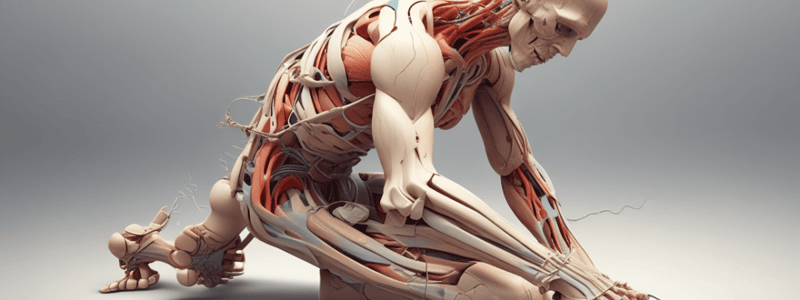Podcast
Questions and Answers
Which modality is mentioned for managing muscle tone and relaxation in acute injuries?
Which modality is mentioned for managing muscle tone and relaxation in acute injuries?
- Heat application (correct)
- Ultrasound therapy
- Electric stimulation
- Cold application
Which of the following is suggested for comfort in conservative management?
Which of the following is suggested for comfort in conservative management?
- Rigid collar
- Neck brace
- Thoracic brace
- Soft collar (correct)
What type of exercises are included for C-spine management in all directions?
What type of exercises are included for C-spine management in all directions?
- Isotonic exercises
- Plyometric exercises
- Isometric exercises (correct)
- Cardio exercises
What does postural education aim to address in conservative management?
What does postural education aim to address in conservative management?
What is the purpose of gentle manual stretching in conservative management?
What is the purpose of gentle manual stretching in conservative management?
What initial head movement is depicted by the first figure in the image related to whiplash-associated disorders?
What initial head movement is depicted by the first figure in the image related to whiplash-associated disorders?
Which figure shows an initial head movement that is backward in the context of whiplash-associated disorders?
Which figure shows an initial head movement that is backward in the context of whiplash-associated disorders?
Identifying whiplash-associated disorders can be indicated by which facial expression in the figures?
Identifying whiplash-associated disorders can be indicated by which facial expression in the figures?
The second figure shown represents which sequence of head movements?
The second figure shown represents which sequence of head movements?
In the context of the provided image, what common cause is suggested for the depicted whiplash-associated disorders?
In the context of the provided image, what common cause is suggested for the depicted whiplash-associated disorders?
Which of the following muscles is NOT listed as being affected by traumatic injury to the C-spine?
Which of the following muscles is NOT listed as being affected by traumatic injury to the C-spine?
What type of movements can cause traumatic injury to C-spine musculoskeletal tissue and ligaments?
What type of movements can cause traumatic injury to C-spine musculoskeletal tissue and ligaments?
What can be a resultant condition due to trauma in the C-spine?
What can be a resultant condition due to trauma in the C-spine?
Which of the following movements is depicted in the image as causing hyperflexion injury to the neck?
Which of the following movements is depicted in the image as causing hyperflexion injury to the neck?
Which muscle groups are involved in the extension of the cervical spine and are likely to be affected by hyperextension injuries?
Which muscle groups are involved in the extension of the cervical spine and are likely to be affected by hyperextension injuries?
Which section of the spine is referred to as the thoracic spine?
Which section of the spine is referred to as the thoracic spine?
How many vertebrae typically make up the thoracic spine?
How many vertebrae typically make up the thoracic spine?
Which ribs articulate directly with the thoracic spine?
Which ribs articulate directly with the thoracic spine?
Which major function is attributed to the thoracic spine?
Which major function is attributed to the thoracic spine?
Which characteristic primarily distinguishes the thoracic vertebrae from others?
Which characteristic primarily distinguishes the thoracic vertebrae from others?
What type of injury is most directly associated with a direct force trauma such as a punch to the face?
What type of injury is most directly associated with a direct force trauma such as a punch to the face?
Which body structure is most vulnerable to injury in the event of a punch as shown in the image?
Which body structure is most vulnerable to injury in the event of a punch as shown in the image?
Which component of pathophysiology involves assessing the bodily response to a trauma like a punch?
Which component of pathophysiology involves assessing the bodily response to a trauma like a punch?
In the context of boxing, what is a likely immediate outcome of a high-impact punch to the head?
In the context of boxing, what is a likely immediate outcome of a high-impact punch to the head?
Which of the following pathomechanical considerations is most relevant in the event of direct force trauma such as seen in boxing?
Which of the following pathomechanical considerations is most relevant in the event of direct force trauma such as seen in boxing?
Which of the following statements is true about the thoracic spine?
Which of the following statements is true about the thoracic spine?
What is the characteristic curve of the thoracic spine?
What is the characteristic curve of the thoracic spine?
Which of these vertebrae views is shown from the side perspective?
Which of these vertebrae views is shown from the side perspective?
From which of the following regions do the ribs originate?
From which of the following regions do the ribs originate?
Which statement is incorrect about the images provided for thoracic vertebrae?
Which statement is incorrect about the images provided for thoracic vertebrae?
What type of trauma is specifically associated with injury to any musculoskeletal component of the thoracic spine?
What type of trauma is specifically associated with injury to any musculoskeletal component of the thoracic spine?
Which activities are given as examples that might cause injury to the thoracic spine through direct or blunt force trauma?
Which activities are given as examples that might cause injury to the thoracic spine through direct or blunt force trauma?
Which of the following injuries is least likely to involve the pathomechanics and mechanisms of injury described?
Which of the following injuries is least likely to involve the pathomechanics and mechanisms of injury described?
What is a potential consequence of blunt force trauma to the thoracic spine?
What is a potential consequence of blunt force trauma to the thoracic spine?
Which of the following is a common cause of thoracic spine injuries according to the content?
Which of the following is a common cause of thoracic spine injuries according to the content?
Which impairment is likely to cause shallow respiration?
Which impairment is likely to cause shallow respiration?
Why might ROM restrictions occur in all directions?
Why might ROM restrictions occur in all directions?
Which activity limitation is directly related to muscle guarding?
Which activity limitation is directly related to muscle guarding?
Which condition is present both as an impairment and a cause of activity limitation?
Which condition is present both as an impairment and a cause of activity limitation?
Which of the following best explains ROM restrictions?
Which of the following best explains ROM restrictions?
Which intervention is recommended to be initiated as the patient's tolerance increases?
Which intervention is recommended to be initiated as the patient's tolerance increases?
Which approach is emphasized to avoid exacerbating symptoms?
Which approach is emphasized to avoid exacerbating symptoms?
What is a primary goal for using modalities in conservative management?
What is a primary goal for using modalities in conservative management?
What types of exercises are introduced when the patient can tolerate them?
What types of exercises are introduced when the patient can tolerate them?
Why is it important to limit certain movements in conservative management?
Why is it important to limit certain movements in conservative management?
What is a common consequence of muscle tenderness and spasms in the cervical spine?
What is a common consequence of muscle tenderness and spasms in the cervical spine?
Which factor contributes to the stiffness and soreness around the cervical spine?
Which factor contributes to the stiffness and soreness around the cervical spine?
Which symptom is associated with decreased cervical ROM in all directions?
Which symptom is associated with decreased cervical ROM in all directions?
Impaired ROM in ADLs primarily affects which aspect of daily function?
Impaired ROM in ADLs primarily affects which aspect of daily function?
How does referred pain to the upper extremities (UE) influence daily activities?
How does referred pain to the upper extremities (UE) influence daily activities?
Flashcards are hidden until you start studying
Study Notes
Whiplash Associated Disorders
- Whiplash motion can cause traumatic injury to C-spine musculoskeletal tissue and ligaments due to flexion-extension, lateral flexion, and acceleration-deceleration type movement.
- Injuries can result in muscle spasms, muscle strains, ligamentous sprains, disc injuries, and vertebral fractures of C-spine.
- Affected muscles include sternocleidomastoid, upper trapezius, scalenes, erector spinae, rhomboids, and levator scapulae.
Clinical Presentation
- Decreased cervical ROM in all directions.
- Pain around C-spine, which can have referred pain to UE.
- Muscle tenderness/muscle spasms.
- Stiffness/soreness due to edema in surrounding tissues.
Activity Limitations and Participation Restrictions
- Impaired ROM during ADLs.
- Limited ADLs involving the arm if referred pain to UE.
Conservative Management
- Use of a soft collar for comfort.
- Pain control and edema management, including modalities.
- Gentle manual stretching of affected muscles and patient self-stretching.
- C-spine isometrics in all directions.
- Postural education/training.
Thoracic Spine
- 12 vertebrae with a kyphotic curve.
- Ribs attach to thoracic vertebrae.
Direct Force Trauma
- Direct force and/or blunt force trauma can cause injury to any musculoskeletal component of the thoracic spine.
- Examples include assault with a weapon, boxing, and/or fighting-related injuries.
Clinical Presentation
- Pain.
- Edema and inflammation of injured and surrounding areas.
- Muscle spasms.
- Bruising.
Activity Limitations and Participation Restrictions
- ROM restrictions in all directions due to pain and inflammation.
- Muscle guarding present due to pain and muscle spasms.
- Respiration may be shallow.
Conservative Management
- Modalities for pain control and decreased edema.
- Initiation of ROM, stretching, resistance training, massage when the patient is able to tolerate.
- Limit movements that exacerbate symptoms.
Studying That Suits You
Use AI to generate personalized quizzes and flashcards to suit your learning preferences.



